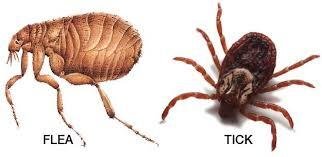
Flea and tick are more than just an annoyance; they pose serious health risks to both humans and pets. These tiny pests can quickly become a major problem if left unchecked, leading to infestations that are difficult to control. Effective flea and tick control is essential to maintaining a safe and healthy environment for your family and pets. In this guide, we’ll explore the dangers of fleas and ticks, the importance of prevention, and how to choose the right flea and tick control plan.
The Dangers of Fleas and Ticks
Keyword: “dangers of fleas and ticks”
Fleas and ticks are notorious for spreading diseases and causing discomfort. Here’s why you should take these pests seriously:
- Health Risks to Pets
“flea and tick risks for pets”
Fleas and ticks are more than just irritants; they can transmit serious diseases to pets. Fleas are known carriers of tapeworms and can cause flea allergy dermatitis, a condition that leads to severe itching and skin infections in pets. Ticks are even more dangerous, transmitting diseases like Lyme disease, Rocky Mountain spotted fever, and ehrlichiosis. These diseases can cause a range of symptoms, from fever and lethargy to joint pain and, in severe cases, death. - Health Risks to Humans
“flea and tick risks for humans”
Fleas and ticks are not just a threat to pets; they can also harm humans. Flea bites can cause itching, allergic reactions, and in some cases, transmit diseases like typhus and plague. Ticks are even more dangerous to humans, as they can transmit Lyme disease and other serious illnesses. The risk of tick-borne diseases increases in areas with high tick populations, making it essential to practice effective control measures. - Infestations
“flea and tick infestations”
Fleas and ticks reproduce quickly, leading to infestations that can spread throughout your home. Fleas lay hundreds of eggs in carpets, furniture, and pet bedding, making it difficult to eliminate them once an infestation has started. Ticks, on the other hand, can attach themselves to pets and humans, and their bites often go unnoticed until they’ve already transmitted a disease.
How to Prevent Flea and Tick Infestations
Keyword: “flea and tick prevention tips”
Preventing fleas and ticks from entering your home is the first line of defense against infestations. Here are some effective prevention tips:
- Regular Pet Grooming
“grooming to prevent fleas and ticks”
Regular grooming is essential for keeping fleas and ticks at bay. Brush your pets regularly to remove any fleas, ticks, or eggs that may be hiding in their fur. Bathing your pets with flea and tick shampoo can also help to kill any existing pests and prevent new ones from taking hold. - Use Flea and Tick Preventatives
“flea and tick prevention products”
There are various flea and tick prevention products available, including topical treatments, oral medications, and collars. These products are designed to kill fleas and ticks on contact and prevent new infestations. Consult with your veterinarian to choose the best product for your pet’s needs and ensure that it is applied or administered as directed. - Maintain a Clean Home
“cleaning tips for flea and tick prevention”
Keeping your home clean is crucial in preventing flea and tick infestations. Vacuum your carpets, rugs, and furniture regularly to remove flea eggs and larvae. Wash your pet’s bedding in hot water and clean areas where your pets spend time. Pay special attention to cracks and crevices where fleas and ticks can hide. - Yard Maintenance
“yard maintenance for flea and tick control”
Fleas and ticks thrive in tall grass, bushes, and leaf litter, so keeping your yard well-maintained is key to preventing infestations. Mow your lawn regularly, trim shrubs and trees, and remove any debris where pests could hide. Consider using a yard spray or granular treatment specifically designed to kill fleas and ticks in your outdoor spaces. - Check Your Pets and Family Regularly
“flea and tick checks”
After spending time outdoors, especially in wooded or grassy areas, check your pets and family members for fleas and ticks. Pay close attention to areas where ticks commonly attach, such as behind the ears, around the neck, and under the arms. Prompt removal of ticks can reduce the risk of disease transmission.
Choosing the Right Flea and Tick Control Plan
Keyword: “best flea and tick control plan”
Selecting the right flea and tick control plan is essential for effectively managing these pests. Here are some options to consider:
- One-Time Treatment
“one-time flea and tick treatment”
A one-time flea and tick treatment is suitable for dealing with an immediate infestation. This service usually includes a thorough inspection and application of insecticides to kill existing fleas and ticks. However, a one-time treatment may not be enough to prevent future infestations, so it’s often best paired with ongoing preventive measures. - Monthly Flea and Tick Control
“monthly flea and tick service”
For continuous protection, a monthly flea and tick control plan is ideal. This plan includes regular applications of flea and tick preventatives, as well as inspections to monitor for any new infestations. Monthly treatments are particularly important in areas with high flea and tick populations or during peak seasons. - Seasonal Flea and Tick Control
“seasonal flea and tick control”
Fleas and ticks are most active during certain times of the year, usually in spring and summer. A seasonal control plan focuses on treating your home and yard during these high-risk months to prevent infestations. This plan is a cost-effective option for homeowners who want targeted protection during peak pest seasons. - Year-Round Protection
“year-round flea and tick prevention”
For the highest level of protection, consider a year-round flea and tick control plan. This comprehensive plan includes regular treatments and inspections throughout the year, ensuring that your home and pets remain protected against fleas and ticks, no matter the season.
Conclusion: Keep Your Home and Pets Safe from Fleas and Ticks
Fleas and ticks are more than just an inconvenience—they pose serious health risks to both pets and humans. By understanding the dangers these pests present and taking proactive steps to prevent infestations, you can keep your home and loved ones safe.
At Adibug, we offer a range of flea and tick control plans tailored to your specific needs. Whether you’re dealing with an active infestation or looking for preventive measures, our expert team is here to provide you with the best solution.
Website: Adibug.com
Phone number: 7578520085







